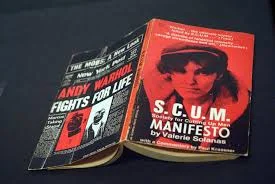The SCUM Society for Cutting Up Men is one of the most controversial and fascinating movements in feminist history. Though the name sounds violent, it isn’t what it first appears to be. The concept originated from Valerie Solanas, a radical feminist writer of the 1960s. Her work, known as the SCUM Manifesto, explored deep frustration with patriarchal systems and male dominance in society. Over time, this term has become the subject of curiosity, debate, and cultural analysis.
In this article, we’ll dive into what the SCUM Society for Cutting Up Men really is, its historical background, core ideas, public reaction, and how it’s understood today.
What Is the SCUM Society for Cutting Up Men?
The SCUM Society for Cutting Up Men was not an official organization but rather a theoretical or symbolic concept introduced by Valerie Solanas in 1967 through her SCUM Manifesto. The term “SCUM” stood for “Society for Cutting Up Men,” and it was meant as a provocative critique of male-dominated power structures rather than a literal call to violence.
Solanas used shocking language to grab attention and to highlight how women were marginalized in politics, economics, and culture. The SCUM Society for Cutting Up Men was her way of urging women to reject oppressive systems and create their own society free from male control.
The Origins of the SCUM Movement
Valerie Solanas was a writer, artist, and radical thinker who lived in New York City during the 1960s. She published the SCUM Manifesto independently in 1967. Around the same time, Solanas was connected to the art scene that included figures like Andy Warhol. Her frustrations with societal structures—and personal experiences of being ignored and exploited—fueled her writing.
After she shot Andy Warhol in 1968 (he survived), Solanas became infamous. The incident led many to misunderstand her manifesto as a violent guide, but in truth, it was a satirical and philosophical critique. Scholars now view the SCUM Society for Cutting Up Men as a radical expression of feminist anger rather than a literal movement.
The Core Ideas Behind the SCUM Manifesto
To understand the SCUM Society for Cutting Up Men, it’s essential to explore the main arguments of the SCUM Manifesto. Solanas believed that:
- Patriarchal society was corrupt.
She argued that men had built systems based on aggression, competition, and greed.
- Women were the future.
Solanas imagined a world where women used technology, intelligence, and cooperation to lead a peaceful, equal society.
- Male dominance needed to end.
The manifesto urged women to “cut up” the systems—meaning to dismantle the power structures that kept them oppressed.
- Independence was key.
Solanas encouraged women to separate from male influence in economics, government, and culture.
Though her writing used extreme and shocking words, many literary experts agree that the manifesto used satire and exaggeration as tools to make a political and philosophical point.
Misunderstandings and Media Reaction
When the SCUM Manifesto first appeared, it sparked controversy. Newspapers labeled Solanas as dangerous and mentally unstable. The name “Society for Cutting Up Men” caused alarm because it sounded like a real call to violence.
However, feminist scholars and later readers realized that Solanas’s work was a metaphorical protest. She wasn’t literally advocating harm; she was demanding attention to how society devalued women.
The SCUM Society for Cutting Up Men became a topic of conversation across feminist, academic, and artistic circles. It forced people to face uncomfortable truths about gender inequality.
The Feminist Context of the 1960s
The 1960s was a decade of social revolutions—civil rights, anti-war protests, and the rise of second-wave feminism. While mainstream feminism focused on equality and workplace rights, Solanas’s SCUM Society for Cutting Up Men took a more radical approach.
Her ideas reflected the anger of women who were tired of being silenced. Solanas’s writing questioned why women were expected to be passive or dependent. She expressed the idea that only a complete social reset could bring justice and freedom for women.
Valerie Solanas: The Woman Behind the Movement
Valerie Solanas was born in 1936 in New Jersey. She studied psychology and showed early signs of independence and defiance against gender roles. Her life was marked by hardship, including poverty and abuse, which shaped her fierce resistance to male power.
She saw herself as both an artist and a revolutionary. Her manifesto was her statement to the world — that women deserved more than just equality; they deserved autonomy and respect.
Unfortunately, her reputation was overshadowed by her act of violence against Andy Warhol. Yet, over time, historians have started to see her not as a villain but as a symbol of rage against systemic oppression.
Literary and Cultural Analysis
The SCUM Society for Cutting Up Men is often studied in literature, gender studies, and philosophy. Scholars describe the SCUM Manifesto as:
- A satirical feminist text that uses shock value to make readers question power.
- A philosophical critique of capitalism, patriarchy, and gender inequality.
- A work of art that combines humor, anger, and irony.
It’s been compared to Jonathan Swift’s “A Modest Proposal,” which also used exaggerated violence to criticize social problems.
Modern Interpretations of SCUM
Today, the SCUM Society for Cutting Up Men is viewed differently than it was in the 1960s. Modern feminists see it as an early example of radical feminist literature, expressing frustration that still feels relevant in discussions about equality and gender roles.
Artists and writers often reference Solanas’s work to discuss:
- The representation of women in media.
- Power dynamics in relationships and institutions.
- The ongoing fight for equality.
While not everyone agrees with her tone, many appreciate her bravery to express what others were too afraid to say.
How People Search for “SCUM Society for Cutting Up Men”
When people look up “scum society for cutting up men” on Google, they usually want to know:
- What the term really means.
- Whether it was a real organization.
- Who Valerie Solanas was and why she wrote the SCUM Manifesto.
- Whether the manifesto promotes violence or is symbolic.
- The cultural and feminist importance of her work.
These searches show that readers are curious, not hostile — they want to understand the background, impact, and ideas behind the phrase.
The search intent is informational: people want knowledge, explanations, and context — not sensationalism.
The Legacy of the SCUM Society for Cutting Up Men
Despite its shocking name, the SCUM Society for Cutting Up Men has left a lasting mark on feminist thought and pop culture. Solanas’s message continues to inspire debates about:
- The limits of feminism.
- The role of women in shaping modern society.
- The use of art and literature to challenge oppression.
Her words remind readers that anger and rebellion can be powerful tools for change — even when expressed through extreme ideas.
Final Thoughts
The SCUM Society for Cutting Up Men was never about literal violence. It was Valerie Solanas’s symbolic rebellion against a world that ignored women’s voices. Through satire, rage, and bold imagination, she pushed the limits of feminist expression.
Today, her manifesto serves as a mirror of society’s gender struggles — past and present. Whether one agrees with her or not, Solanas forced the world to think differently about power, gender, and justice.


